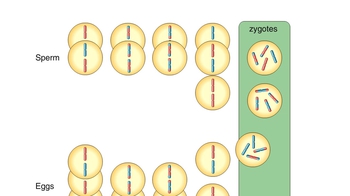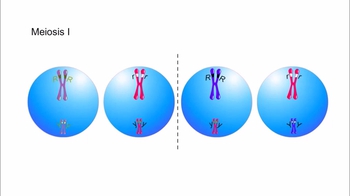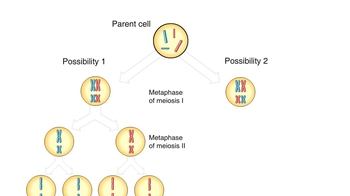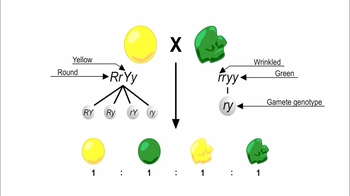12. Meiosis
Genetic Variation During Meiosis
Learn with other creators
Practice this topic
- Multiple Choice
Which of the following processes occurs when homologous chromosomes cross over in meiosis I?
4260views39rank - Multiple Choice
Crossing over involves each of the following EXCEPT:
3293views29rank1comments - Multiple Choice
How many genetically unique gametes can be created in an organism with 4 chromosomes?
4858views12rank8comments - Multiple Choice
During which of the following processes does independent assortment of chromosomes occur?
4080views16rank - Textbook Question
What is an outcome of genetic recombination?
a. The synapsing of homologs during prophase of meiosis I
b. The new combination of maternal and paternal chromosome segments that results when homologs cross over
c. The new combinations of chromosome segments that result when self-fertilization occurs
d. The combination of a haploid phase and a diploid phase in a life cycle
1042views - Textbook Question
A wild-type fruit fly (heterozygous for gray body color and normal wings) is mated with a black fly with vestigial wings. The offspring have the following phenotypic distribution: wild-type, 778; black vestigial, 785; black normal, 158; gray vestigial, 162. What is the recombination frequency between these genes for body color and wing size? Is this consistent with the results of the experiment in Figure 15.9?
<IMAGE>
3373views2rank - Textbook Question
A planet is inhabited by creatures that reproduce with the same hereditary patterns seen in humans. Three phenotypic characters are height (T=tall,t=dwart), head appendages (A=antennae,a=no antennae), and nose morphology (S=upturned snout,s=downturned snout). Since the creatures are not 'intelligent,' Earth scientists are able to do some controlled breeding experiments using various heterozygotes in testcrosses. For tall heterozygotes with antennae, the offspring are tall antennae, 46; dwarf antennae, 7; dwarf no antennae, 42; tall no antennae, 5. For heterozygotes with antennae and an upturned snout, the offspring are antennae upturned snout, 47; antennae downturned snout, 2; no antennae downturned snout, 48; no antennae upturned snout, 3. Calculate the recombination frequencies for both experiments.
1778views - Textbook Question
Nondisjunction that leads to problems in offspring can occur in:
a. Mitosis
b. Meiosis I only
c. Meiosis I and II
d. Mitosis, meiosis I, and meiosis II
1291views














